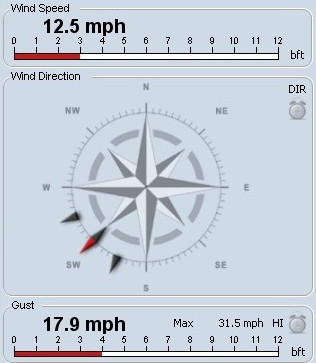
Critters, ISS, Full Moon with D7000 DSLR
Posted: 26 April 2013
Captured another live pack rat from near the observatory on Wednesday, 24 April 2013, and another one on Thursday. Both were relocated. Count is now six live ones and two dead ones. Also, on Thursday, saw this while I was checking the pack rat traps:

About 5' long. Might be a "red racer".
The sky was cloudy Wednesday night, but cleared on Thursday with a strong wind:

In anticipation of the wind dying down, and since there was to be a good ISS pass about an hour after sunset, the observatory was opened Thursday, 25 April, at 1840 MST, 77°F. I delayed opening the dome until 1853 MST to let the wind decrease some more. I then synced the observatory clock to WWV. At 1910 MST, powered on the 8" LX200-ACF and viewed Jupiter, 83X. The Great Red Spot and the four Galilean Moons were visible.
I updated the TLE for the International Space Station (ISS). I slewed to the star Sirius, which would be the focus test star using the Bahtinov Mask. While waiting for the wind to end a visitor came by:

With the wind now calm, I mounted the D7000 DSLR at prime focus and did the focus test image at 1937 MST. Locked the telescope focus and tweaked the alignment of the Antares 7x50 Illuminated Crosshairs Finderscope. I was now ready for the ISS to begin in about 30 minutes. The eastern sky was brightening from the rising, just past full, moon. The ISS pass began at 2010 MST. Initial pointing was off a few degrees, but once I got the ISS centered in the finderscope, tracking was pretty good for most of the pass. This pass was a northerly one and as usual, tracking went somewhat berserk as the ISS passed near the North Celestial Pole. Here are four views of the ISS around mid-pass from the HD video, 1/2000sec, ISO 2500, showing the changing perspective:

Removed the camera from the telescope and at 2021 MST, viewed Saturn low in the sky and through a tree to the southeast using the 2" 24mm UWA eyepiece (83X). At 2027 MST, the moon began to appear over the hill to the southeast (and through the tree). I viewed the moon, 83X; a very slight terminator was visible 7.5 hours after 100% full phase.
At 2043 MST, added the focal reducer to the telescope and mounted the D7000 DSLR at prime focus + 2" visual back. I then began waiting for the moon to rise above the tree. At 2130 MST, I captured this image, 1/500sec, ISO 100, cropped from the full-frame photograph:

Removed the camera and at 2136 MST, viewed the moon, 83X. It was very bright in the 2" ultra-wide angle eyepiece. I needed a 2" moon filter (which I don't have), or I needed to switch to my 1.25" 26mm eyepiece with the 1.25" moon filter (which I didn't do) to view a bright moon.
Closed the observatory at 2148 MST, 57°F.
Comments are welcome; use the Comments section below, or you can Email Me. Thanks.
Cassiopeia Observatory Home Page